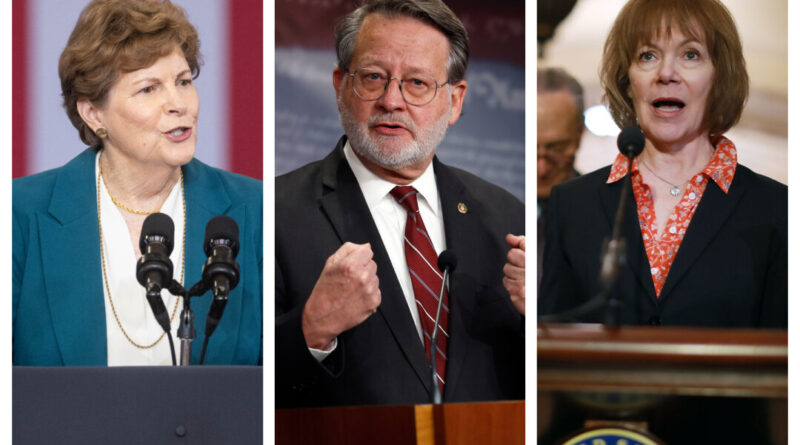Three Key Senate Democrats Retire: Implications for the 2026 Elections
The recent retirements of several Democratic legislators could open up opportunities for Republican candidates that were previously unavailable.
Three veteran Democratic senators have declared that they will not seek reelection, igniting speculation about the potential outcomes of the 2026 midterm elections.
Since the Republicans gained a trifecta in Washington in November, Senators Jeanne Shaheen (D-N.H.), Gary Peters (D-Mich.), and Tina Smith (D-Minn.) have confirmed their retirements.
Each of these seats is located in states where election margins were under five points in 2024, making them prime targets for either party.
Some analysts interpret the departure of these Democratic incumbents as an indication that the Republicans are poised to expand their current 53-seat majority in the Senate.
Republican strategist Matt Johnston told The Epoch Times that these retirements suggest a momentum shift towards the GOP.
“When incumbents retire, it often indicates that they feel unprepared for an upcoming fight, and simply can’t muster the energy anymore,” Johnston remarked.
Other analysts provided different perspectives, many arguing that it’s premature to reach any firm conclusions.
Here’s what you need to know about the retirements and their implications for the 2026 midterm elections.
New Hampshire
The Granite State is historically known for its independent leaning.
In 2024, Republicans achieved a trifecta led by Gov. Kelly Ayotte. However, during the same election, Vice President Kamala Harris narrowly defeated Donald Trump by 2.78 percent.
Senator Shaheen, who has served since 2009 and was governor from 1997 to 2003, won her last election by about 16 points in 2020, becoming the first Democrat in New Hampshire history to serve three full Senate terms.
Her exit paves the way for Republicans to potentially reclaim a Senate seat in New Hampshire for the first time since 2016.
Political Science Professor Richard Groper from California State University indicated that a strong candidate for Republicans would be former Gov. Chris Sununu, who left office in January.
“New Hampshire can be unpredictable, given its purple status. It leans blue, yet has a red governor,” Groper commented. “If Sununu runs, his strong name recognition could pose a challenge for Democrats.”
Sununu has been non-committal regarding his plans.
For the Democrats, potential candidates include Reps. Chris Pappas (D-N.H.) and Maggie Goodlander (D-N.H.), with Goodlander’s husband, Jake Sullivan, serving as President Joe Biden’s national security adviser.
Despite the state’s contested nature, securing New Hampshire remains a tall order for Republicans.
Ayotte was the last Republican senator from the state, losing to Sen. Maggie Hassan (D-N.H.)—another former governor—in a razor-thin 0.14 percent race in 2016. Nevertheless, Hassan defeated her Republican opponent in 2022 by nearly 10 points.
Regardless, Republicans view Shaheen’s departure as an opportunity to widen their Senate majority, especially if Sununu throws his hat in the ring.
Minnesota
Minnesota is primarily known for its consistent support of Democrats, which has held true at the presidential level since 1972.
At the Senate level, only five Republicans have been elected since 1952, with just one of them serving a full term in the 21st century.
However, signs are emerging that Minnesota could be evolving into a battleground state, particularly since two of the last three presidential elections were decided by margins of under 5 percent.
As a result, Republicans have increasingly set their sights on Minnesota amid a wider rightward shift across the Rust Belt.
Smith joined the Senate in 2018 after being appointed to replace Sen. Al Franken (D-Minn.) and won reelection by a margin of 5.3 percent in 2020.
Democratic-Farmer-Labor Party (DFL) candidates include Minnesota Lt. Gov. Peggy Flanagan and former Senate Minority Leader Melisa López Franzen. On the Republican side, former Navy SEAL Adam Schwarze and former NBA player Royce White are running.
Dan Meyers, an associate politics professor at the University of Minnesota, expressed his belief that Democrats will retain the seat in this election cycle.
“Notably, several prominent DFL figures—including Flanagan, Rep. Angie Craig (D-Minn.), and Rep. Ilhan Omar (D-Minn.)—have either declared or expressed interest, while all Republican congressional members from the state have chosen not to run,” Meyers noted.
Johnston concurred that flipping Minnesota will be challenging but asserted, “Anything’s possible.”
Michigan
Historically, Michigan has been viewed as the most liberal among the Rust Belt trio—Michigan, Pennsylvania, and Wisconsin—but analysts believe it could represent the Republicans’ best chance for a flip in 2026.
Peters, who has built his reputation as a champion for Michigan’s working class, announced his retirement on January 28.
Joshua Koss, a politics professor at Eastern Michigan University, remarked that Peters’s retirement is a significant development.
“Michigan has consistently been recognized as a swing state in recent election cycles at the presidential level, and while Republicans haven’t held a Senate seat from the state since 2000, this open seat might provide them a rare opportunity,” Koss explained.
Even if the Democrats manage to retain the seat, Peters’s departure suggests that significantly more resources will be necessary.
It’s worth noting that Peters chairs the Democratic Senatorial Campaign Committee, Senate Democrats’ campaign arm—this could have substantial repercussions on the outcomes of the 2026 midterm elections.
Johnston emphasized that Republicans are most optimistic about this race, pointing to the absence of prominent Democratic candidates so far.
Current potential candidates include Sen. Mallory McMorrow (D-Mich.), Attorney General Dana Nessel, and Reps. Haley Stevens (D-Mich.), Hillary Scholten (D-Mich.), and Rashida Tlaib (D-Mich.).
On the Republican side, former Rep. Mike Rogers (R-Mich.) is anticipated to announce a run after narrowly losing the 2024 Senate race to Sen. Elissa Slotkin (D-Mich.), and several other contenders are expected to enter the race as well.
Shape of the 2026 Race
Regardless of the outcome, these Democratic retirements present new opportunities for Republican candidates that did not exist before.
The 2026 election landscape was already expected to be favorable for Republicans, with most GOP seats situated in securely red districts.
Before the retirements were announced, Peters’s seat in Michigan was already regarded as a significant target for the GOP, along with Sen. Jon Ossoff’s (D-Ga.) seat in the Peach State.
Only two Republican senators—Susan Collins (R-Maine) and Thom Tillis (R-N.C.)—are likely to face serious challenges concerning their positions.
Ultimately, analysts believe it’s premature to predict outcomes in these races, as results will largely hinge on the political climate in 2026.
Nevertheless, a number of experts pointed out that historical patterns may pose a challenge for Republicans, given that the party in power typically loses seats during midterm elections.
The Associated Press contributed to this report.





